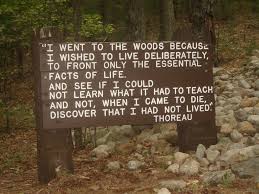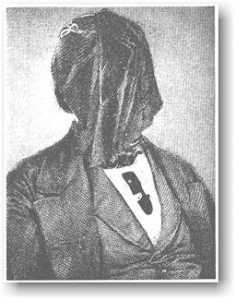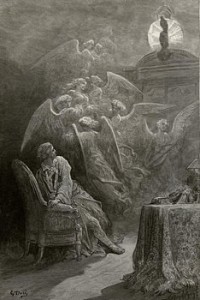English 3P Honors: Unit Goal
Write an essay that defines American Romanticism’s views of TRUTH AND KNOWLEDGE and examines their use of stylistic devices such as imagery, figures of speech, paradox and symbolism to communicate philosophical attitudes and themes.
“To speak truly, few adult persons can see nature. Most persons do not see the sun. At least they have a very superficial seeing. The sun illuminates only the eye of the man, but shines into the eye and the heart of the child. The lover of nature is he whose inward and outward senses are still truly adjusted to each other; who has retained the spirit of infancy even in the era of manhood. ” –Ralph Waldo Emerson
Unit Essential Questions:
1. What is TRUTH? What is KNOWLEDGE?
2. How did American Romantics view TRUTH AND KNOWLEDGE?
3. How did American Romantics views about TRUTH AND KNOWLEDGE as expressed in Romantic essays, poetry, and shorts stories define the “American” as an idea and the United States of America as a political and cultural entity?
4. How did views of TRUTH as expressed in Romantic literature in U.S. history inspire and shape artistic, cultural, and political movements?
5. How have American Romantic writers and artists influenced current “American” values and politics?
Unit Goal
Write an essay that defines American Romanticism’s views of TRUTH AND KNOWLEDGE and examines their use of stylistic devices such as imagery, figures of speech, paradox and symbolism to communicate philosophical attitudes and themes.
Unit Terms
Romanticism, intuition, Transcendentalism, Dark Romanticism, Romantic Hero, Mood, Setting, Diction, Theme, metaphor, imagery , tone, personification, symbolism, paradox, civil disobedience, allegory, parable, archetype,
Objective 1: Historical Context
Students can define features of American Romanticism as a cultural and intellectual movement that arose out of the historical context of the early 19th century by completing notes and American Romanticism Pamphlet, and identifying Romantic features in “Thanatopsis” by Willaim Cullen Bryant.
 Objective 2: Transcendentalism & TRUTH in Nature
Objective 2: Transcendentalism & TRUTH in Nature
By reading and annotating Transcendentalist literature, students will be able to: 1.) identify philosophical attitudes and themes 2.) analyze the effect of imagery, figures of speech and symbolism to communicate views on NATURE.
A. Nature and Self-Reliance by Ralph Waldo Emerson, pp. 179-188
I. Pre-Reading: Emerson, Ralph Waldo, Emerson’s Transcendentalism Notes, Mood Words
II. Reading: Say Means Matters Template for “Nature”, Says Means Matters Template for “Self Reliance”
III. Post-Reading: Summary Template
Web Resources: http://www.rwe.org/, www.transcendentalists.com

B. Thoreau, Henry David. from “Walden” & from “Resistance to Civil Government”
I. Pre-Reading: Thoreau Notes
II. Reading: Says-Means-Matters —
III. Post-Reading: Summary Template
Web Resources: Henry David Thoreau: Who He Was and Why He Mattered
Objective 3: Dark Romanticism & TRUTH in Death
By reading and annotating Dark Romantic literature, students will be able to: 1.) compare philosophical attitudes and themes communicated through allegory and 2.) analyze the effect of imagery, figures of speech and symbolism to communicate views on DEATH.
 A. Hawthorne, Nathaniel. “The Minister’s Black Veil” pp. 238-252 & Dr. Heidegger’s Experiment pp.228-237
A. Hawthorne, Nathaniel. “The Minister’s Black Veil” pp. 238-252 & Dr. Heidegger’s Experiment pp.228-237
I. Pre-Reading: Notes
II. Reading: Says-Means-Matters Template, Says-Means-Matters “Dr. Heidegger’s Experiment”
III. Post Reading: Summary Template
Web Resources: http://www.eldritchpress.org/nh/hawthorne.html

B. Edgar Allan Poe, “The Raven” & “The Pit and the Pendulum” pp. 253-279
I. Pre-Reading: Poe Notes, Intro Film Clip
II. Reading: “The Raven”
“The Pit and the Pendulum” pp. 255-268, & Analysis
III. Post Reading: Summary Template
Web Resources: http://www.poemuseum.org
Objective 4: Literary Analysis Essay
By writing a literary analysis essay, students will be able to reveal their ability to 1.) identify attitudes and themes of American Romantics and analyze their use of imagery, figures of speech, paradox and symbolism to communicate philosophical views and 2.) Compare philosophical attitudes and literature of Transcendentalist and Dark Romantics.
II. Prompt & Rubric, Writing Guide & Template
III. Peer Response and Revision Guide, UNIT SELF ASSESMENT AND REFLECTION
